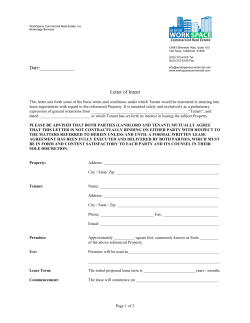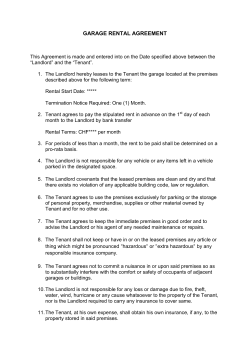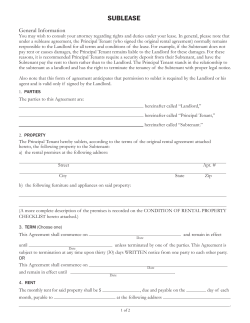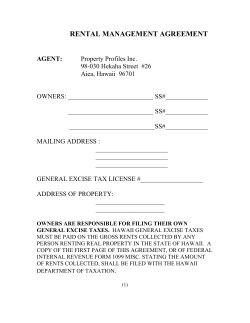
Oklahoma Cropland Rental Rates: 2012-13 CR-230 Damona Doye
Oklahoma Cooperative Extension Service CR-230 Current Report 0313 Oklahoma Cooperative Extension Fact Sheets are also available on our website at: osufacts.okstate.edu Oklahoma Cropland Rental Rates: 2012-13 Damona Doye Roger Sahs Regents Professor and Extension Economist Rental agreements and rates are influenced by the landowner’s costs, the tenant’s expected earnings, previous rates charged, competition for the land, government programs, tax laws, and the non-agricultural economy. The results of a statewide farmland leasing survey conducted in 2012 are reported here. Respondents were individuals contacted through the Oklahoma Cooperative Extension Service who agreed to complete periodic surveys plus recipients of a mailing by the Oklahoma Agricultural Statistics Service. Approximately 270 surveys were returned with useable data. Figure 1 shows the regions of the state used in reporting survey results: northwest, southwest, northcentral, and east. On average, crop cash lease agreements had been in effect for 15 years (Table 1). Average lease sizes ranged from 209 acres in eastern Oklahoma to 550 acres in Northcentral Oklahoma. Most tenants and landlords in Oklahoma appear to be satisfied with their lease agreements. Sixty-eight percent of respondents with cash lease agreements crop share agreements classified their leasing agreements as either good or excellent from a standpoint of fairness. Twenty-two percent of respondents with cash lease agreements and 24% of respondents with crop share agreements classified their leasing agreements as adequate from the standpoint of fairness. Northwest Cropland Cash Rental Rates Cash leases require a fixed payment, typically cash (or infrequently, a specified yield such as 10 bushels of wheat). Survey results document some regional differences in rental rates and average sizes of tracts rented. Cash rental rates for dryland wheat were highest in the north-central region of the state, averaging $38.48 per acre, compared to $28.10 to $32.19 in other regions of the state (Table 2).1 The range in reported rental rates was from $15 to $67 per acre. The state average of $32.80 increased more than $1 per acre compared to the 2010 average of $31.78. Northwestern and southwestern areas reported slight regional declines, however. Figure 2 shows the distribution of responses (128) for dryland wheat cash rental rates. None of the respondents reported a rental rate less than $10 per acre, 6% reported a rental rate between $10 and $19 per acre, 30% reported a rental rate between $20 and $29 per acre, 31% reported a rental rate between $30 and $39 per acre, 23% reported a rental rate between $40 and $49 per acre, and 9% of the respondents reported a rental rate of $50 or more per acre. Dryland grain sorghum average rental rates were less than wheat at $29.66 per acre while dryland alfalfa averaged significantly higher than wheat at $41.00 per acre. (Note that there were only 7 responses on both grain sorghum and dryland alfalfa rates, thus the averages and distributions are less reliable than they would be with more observations.) Cropland Share Rental Rates Northcentral Southwest Extension Assistant Specialist In a crop share lease, certain costs are often shared in the same proportion that production is shared.2 In crop share leases statewide, the tenant on average receives around 2/3 of dryland wheat, alfalfa, or grain sorghum, while paying that or more of the fertilizer, herbicide, insecticide, and chemical application expenses (Table 3). On average, the tenant pays nearly all seed and harvesting (combining, hauling, cutting, raking, baling) expenses. Figure 3a shows the distribution of survey responses regarding the tenant’s share of production. Figure 3b shows East Figure 1. Regions Used in Reporting Farmland Leasing Survey Results 1 Averages reported are the simple average of rates reported by the respondents. They are not weighted by acres in the lease agreement. 2 Advantages and disadvantages of different types of lease agreements are discussed in OSU Extension Fact Sheets AGEC-214 and AGEC-215. Division of Agricultural Sciences and Natural Resources • Oklahoma State University the distribution of responses for the tenant’s share of crop inputs and expenses. These graphs indicate that the tenant typically pays either 2/3 or all of the fertilizer, herbicide, insecticide, chemical application and lime costs. Chemical applications in particular are frequently paid entirely by the tenant. The graphs also show that the tenant typically pays all seed, harvesting, and hauling costs. Figure 3c shows the distribution of responses for hay inputs and expenses. The results for hay are similar to crops in that the tenant typically pays all seed, harvesting (cutting, raking and baling) and hauling costs. Although the tenant typically pays 2/3 or all of the fertilizer, herbicide, insecticide and chemical application costs, the proportion of tenants paying 100% is higher for fertilizer on hay than other crops. Other Lease Terms Many lease agreements specify terms and conditions beyond the rental rate, which affect the value of the lease and the “real” rental rate. For instance, tenants may or may not be allowed to hunt, harvest pecans, graze cattle, cut timber, use buildings, improvements, and lease out hunting privileges. Lime application costs or similar costs for improvements in which the benefits are shared over a number of years may be shared by the landlord and tenant, or if the tenant pays for them initially, repaid by the landlord at a fixed rate per year. Tenants may be required to maintain fences, spray weeds annually, provide liability insurance, share oil field damages, maintain terraces, and leave strips of grain in the field for game. Landlords may provide a well and water, fencing material, or land for a mobile home. Tenants may ask for several months notice if the landlord wishes to terminate the lease agreement. In some cases, leases contain an option to buy with rental payments applied to the purchase price. Related Publications To help educate landlords and tenants with equitable lease agreements and current best management practices, visit the Oklahoma State University (OSU) Ag Land Lease website at http://www.aglandlease.info or http://www.aglease. info. A joint effort between OSU’s Plant and Soil Sciences and Agricultural Economics Departments, the website contains a wide assortment of farm management spreadsheet tools, lease information and forms, rental rate and land value resources, legal and tax considerations plus the latest production practices in Oklahoma. Specific addresses for the several referenced North Central Farm Management Extension Committee (NCFMEC) publications are: Crop Share Rental Arrangements For Your Farm, NCFMEC-2 at http://aglandlease.info/wp-content/uploads/2012/05/ Crop-Share.pdf Fixed and Flexible Cash Rental Arrangements For Your Farm, NCFMEC-1 at http://aglandlease.info/wp-content/ uploads/2012/05/Fixed-and-Flexible.pdf Pasture Rental Arrangements, NCFMEC-3 at http:// aglandlease.info/wp-content/uploads/2012/05/PastureRental.pdf Recent Oklahoma school land lease auction information is also available through the Real Estate Management Division of Commissioners of the Land Office at http://oklaosf.state. ok.us/~clo/. 50 Historical and Regional Perspective Average-$32.80 n=128 45 Table 4 provides historical data on pasture rental rates for Oklahoma, Kansas, Arkansas, and Texas for 2003-2012 as reported by the USDA National Agricultural Statistics Service. 40 35 Concluding Comments 30 30 % of Responses “Fair” rents must be negotiated between tenant and landlord. Regional or state average rental rates may be used as a beginning point for discussion and negotiation of rental rates. However, differences in land quality, improvements, and restrictions on land use can greatly impact the value of potential leases. Likewise, differences in family living expenses and hired labor costs can be substantial for different operations, affecting the maximum rental bids. New legal restrictions and liability factors may instigate changes in future farm lease agreements. Some farm management firms include language that explicitly requires the tenant to be a good steward of the land. The tenant is expected to follow label restrictions in the use of pesticides, to remain in compliance with the farm’s conservation plan, and to dispose of wastes in a manner approved by the Environmental Protection Agency. Some leases already stipulate precisely what fertilizers, pesticides, and seed may be used on the property. Both landlords and tenants must be aware of changing environmental laws and regulations to avoid potentially costly liabilities. 31 25 23 20 15 9 10 6 5 0 0 0 - 9.99 10 - 19.99 20 - 29.99 30 - 39.99 40 - 49.99 50+ Rental Rate ($/acre) Figure 2. Relative Frequency of Responses for Dryland Wheat Cash Rental Rates, 2012. CR-230.2 Table 1. Crop Cash Agreement Statistics by Region, 2012-13. Northwest Average Range Number of Observations Average Range Number of Observations Southwest Northcentral East 486 80-1,920 45 523 16-2,225 57 Acres in Lease 550 26-6,500 41 209 30-1,100 46 18 1-50 16 2-100 Average Years Lease Held 15 1-55 11 1-60 39 55 37 44 State 443 16-6,500 189 15 1-100 175 Table 2. State Crop Cash Rental Rates, 2012-13. Cash Rent per Acre Average Range No. of Observations Dryland Wheat Northwest Southwest Northcentral East State $28.10 $32.07 $38.48 $32.19 $32.80 $15-49 $15-55 $20-55 $20-67 $15-67 Dryland Grain Sorghum $29.66 $16-45 Dryland Alfalfa $41.00 $30-50 7 Other Dryland Crops1 $39.38 $23-95 20 Other Irrigated Crops2 $66.25 $38-100 6 32 45 34 17 128 7 1 Other dryland crops (number of observations in parenthesis) include annual forages (6), soybeans (6), corn (4), cotton (2) and other small grains (2). 2 Other irrigated crops (number of observations in parenthesis) include grains (3), alfalfa (2) and cotton (1). CR-230.3 Table 3. Crop Share Lease Provisions (Tenant’s Share), 2012-13. Acres in Lease Average Years Lease Held Average Range No. of Observations 373 16 15-3,520 1-60 138 126 ——————————Tenant’s Share of Receipts (Percentage)————————— Dryland Wheat Dryland Alfalfa Dryland Grain Sorghum Other Hay Other Crops 66 67 66 63 69 50-75 50-75 50-75 50-90 67-75 106 12 13 16 8 ——————————Tenant’s Share of Expenses (Percentage)————————— Crop Seed Fertilizer Herbicide Insecticide Chemical Applications Harvesting Hauling Irrigation Energy Lime Application1 Cotton Ginning and Processing Hay and Other Seed Fertilizer Herbicide Insecticide Chemical Applications Cutting Raking Bailing Hay Hauling Irrigation Energy2 Lime Application1 Average Range No. of Observations 97 75 83 81 87 96 95 93 64 84 50-100 50-100 50-100 50-100 50-100 50-100 50-100 67-100 0-100 67-100 107 113 105 93 103 91 49 9 41 9 93 77 76 69 86 93 93 93 88 67-100 50-100 50-100 50-100 50-100 50-100 50-100 50-100 50-100 9 16 13 10 14 34 34 34 29 — — — 43 0-100 7 Rental shares of 100% of the crop for the tenant or zero percent of expenses are generally special situations, usually reflecting concessions or unusual circumstances in another part of the lease. However, as lime improves the soil and this improvement is retained by the landlord if the lease is terminated, it is not unusual for the landlord to pay all lime expenses. 2 Insufficient information. 1 CR-230.4 Table 4. Average Gross Cash Rent (Dollars per Acre) for Cropland, Selected States, 2003-2012. 20032004 2005 2006 20072008 2009 2010 2011 2012 Oklahoma Dryland 27.5030.00 29.00 28.00 27.0028.00 28.00 28.00 28.00 31.00 Kansas Dryland Irrigated 36.0037.50 68.0072.00 38.50 73.00 39.00 74.00 41.0042.50 82.0092.00 43.50 89.00 43.50 95.00 44.00 105.00 52.50 119.00 Missouri Dryland 70.0076.00 79.00 79.00 79.0080.00 90.00 94.00 101.00 103.00 Texas Dryland Irrigated 21.0023.70 555.00 56.00 23.00 57.50 23.00 62.00 23.0024.00 65.0080.00 25.00 77.00 26.00 75.00 28.00 77.00 25.00 79.00 Source: Agricultural Statistics Service, Oklahoma Agricultural Statistics 2012, USDA/NASS, Oklahoma Department of Agriculture, http://www.nass.usda.gov/ok/. Figure 3a. Relative frequency of responses for items in cropland share agreements, 2012-13. Production Dryland Wheat Dryland Alfalfa 100 100 Average Tenant’s Share: 66% n = 106 87 n = 12 Average Tenant’s Share: 67% 80 80 % of Responses % of Responses 67 60 40 20 60 40 0 0 0 5 0 1 - 35 36 - 63 64 - 71 72 - 80 0 0 81 - 99 100 0 17 17 20 8 0 0 0 1 - 35 36 - 63 Other Hay Average Tenant’s Share: 63% 0 100 Dryland Grain Sorghum 100 80 56 38 n = 13 Average Tenant’s Share: 66% 80 75 % of Responses % of Responses 60 n =8 Average Tenant’s Share: 69% n = 16 80 % of Responses 0 81 - 99 Other Crops 100 40 72 - 80 Tenant’s Share Tenant’s Share 100 64 - 71 60 40 77 60 40 25 20 20 20 15 8 6 0 0 0 0 1 - 35 0 36 - 63 64 - 71 72 - 80 Tenant’s Share 0 81 - 99 100 0 0 0 0 1 - 35 0 36 - 63 64 - 71 72 - 80 Tenant’s Share CR-230.5 0 0 81 - 99 100 0 0 0 0 1 - 35 36 - 63 64 - 71 72 - 80 Tenant’s Share 0 0 81 - 99 100 Figure 3b. Relative frequency of responses for items in cropland share agreements, 2012-13. Crop Inputs and Expenses Seed Fertilizer Herbicide 100 100 Average Tenant’s Share: 97% 100 93 n = 107 Average Tenant’s Share: 75% n = 113 80 n = 105 Average Tenant’s Share: 83% 80 80 60 40 % of Responses % of Responses % of Responses 62 60 40 60 50 42 40 27 20 20 20 6 0 2 1 - 35 36 - 63 0 0 0 6 0 64 - 71 0 72 - 80 0 0 81 - 99 0 100 5 1 - 35 36 - 63 Insecticide n = 93 Average Tenant’s Share: 81% 100 20 20 1 - 35 36 - 63 64 - 71 0 72 - 80 81 - 99 0 100 0 0 0 1 - 35 4 36 - 63 64 - 71 72 - 80 0 81 - 99 100 Average Tenant’s Share: 64% 80 80 60 60 40 40 20 6 0 0 1 - 35 100 n = 41 32 64 - 71 0 72 - 80 81 - 99 100 0 1 - 35 64 - 71 60 44 33 22 20 0 0 1 - 35 0 0 36 - 63 64 - 71 72 - 80 Tenant’s Share n=9 Average Tenant’s Share: 84% 0 64 - 71 72 - 80 1 81 - 99 100 n=9 Average Tenant’s Share: 93% 78 60 40 0 36 - 63 80 0 36 - 63 7 Cotton Ginning 40 1 - 35 3 20 15 2 Tenant’s Share 100 0 4 22 17 2 0 36 - 63 0 80 6 0 3 0 Irrigation Energy 27 20 88 Tenant’s Share 100 86 100 40 Lime Application n = 49 81 - 99 n = 91 Average Tenant’s Share: 96% Tenant’s Share Hauling Average Tenant’s Share: 95% 0 72 - 80 60 0 % of Responses 0 3 0 64 - 71 20 5 Tenant’s Share 0 % of Responses 61 30 0 3 36 - 63 80 40 40 100 100 n = 103 Average Tenant’s Share: 87% 44 0 1 - 35 Harvesting 60 46 6 0 Tenant’s Share 80 60 0 Application of Chemicals 80 % of Responses 81 - 99 100 100 % of Responses 72 - 80 0 0 Tenant’s Share Tenant’s Share % of Responses 64 - 71 6 0 0 72 - 80 81 - 99 100 Tenant’s Share CR-230.6 81 - 99 0 100 0 0 0 1 - 35 0 0 36 - 63 64 - 71 72 - 80 Tenant’s Share 0 81 - 99 100 Figure 3c. Relative frequency of responses for items in cropland share agreements, 2012-13. Hay Inputs and Expenses Seed Fertilizer Average Tenant’s Share: 77% n=9 % of Responses 60 40 n = 16 80 78 80 100 60 40 38 38 22 n = 13 60 38 40 31 23 19 20 20 Average Tenant’s Share: 76% 80 % of Responses Average Tenant’s Share: 93% % of Responses Herbicide 100 100 20 6 0 0 0 0 0 72 - 80 81 - 99 0 0 1 - 35 36 - 63 64 - 71 0 0 0 100 0 0 1 - 35 36 - 63 64 - 71 72 - 80 0 81 - 99 8 0 0 0 100 0 1 - 35 36 - 63 Tenant’s Share Insecticide Average Tenant’s Share: 69% 100 n = 10 80 72 - 80 81 - 99 100 Tenant’s Share Application of Chemicals 100 64 - 71 Cutting 100 n = 14 Average Tenant’s Share: 86% Average Tenant’s Share: 93% 80 n = 34 85 80 60 50 40 30 20 20 0 0 0 0 1 - 35 36 - 63 64 - 71 0 0 72 - 80 81 - 99 % of Responses % of Responses % of Responses 64 60 40 21 20 0 100 0 0 1 - 35 12 0 36 - 63 Tenant’s Share Raking n = 34 0 100 0 100 n = 34 85 40 1 - 35 60 40 20 12 0 64 - 71 0 0 72 - 80 81 - 99 100 Tenant’s Share 0 0 0 0 1 - 35 3 0 36 - 63 64 - 71 Lime Application n=7 80 60 43 40 29 29 20 0 0 0 1 - 35 36 - 63 72 - 80 Tenant’s Share 100 Average Tenant’s Share: 43% 0 0 0 64 - 71 72 - 80 81 - 99 64 - 71 0 0 72 - 80 81 - 99 Average Tenant’s Share: 88% 100 Tenant’s Share CR-230.7 100 n = 29 72 60 40 20 12 3 36 - 63 36 - 63 80 % of Responses 60 0 1 - 35 Tenant’s Share 80 0 3 0 Hauling Average Tenant’s Share: 93% 85 % of Responses % of Responses 81 - 99 0 Baling 20 % of Responses 72 - 80 100 80 0 64 - 71 0 Tenant’s Share 100 Average Tenant’s Share: 93% 40 20 14 0 60 0 81 - 99 100 0 17 0 0 10 0 1 - 35 36 - 63 64 - 71 0 0 72 - 80 81 - 99 Tenant’s Share 100 The Oklahoma Cooperative Extension Service Bringing the University to You! The Cooperative Extension Service is the largest, most successful informal educational organization in the world. It is a nationwide system funded and guided by a partnership of federal, state, and local governments that delivers information to help people help themselves through the land-grant university system. Extension carries out programs in the broad categories of agriculture, natural resources and environment; family and consumer sciences; 4-H and other youth; and community resource development. Extension staff members live and work among the people they serve to help stimulate and educate Americans to plan ahead and cope with their problems. Some characteristics of the Cooperative Extension system are: • • The federal, state, and local governments cooperatively share in its financial support and program direction. It is administered by the land-grant university as designated by the state legislature through an Extension director. • Extension programs are nonpolitical, objective, and research-based information. • It provides practical, problem-oriented education for people of all ages. It is designated to take the knowledge of the university to those persons who do not or cannot participate in the formal classroom instruction of the university. • It utilizes research from university, government, and other sources to help people make their own decisions. • More than a million volunteers help multiply the impact of the Extension professional staff. • It dispenses no funds to the public. • It is not a regulatory agency, but it does inform people of regulations and of their options in meeting them. • Local programs are developed and carried out in full recognition of national problems and goals. • The Extension staff educates people through personal contacts, meetings, demonstrations, and the mass media. • Extension has the built-in flexibility to adjust its programs and subject matter to meet new needs. Activities shift from year to year as citizen groups and Extension workers close to the problems advise changes. Oklahoma State University, in compliance with Title VI and VII of the Civil Rights Act of 1964, Executive Order 11246 as amended, Title IX of the Education Amendments of 1972, Americans with Disabilities Act of 1990, and other federal laws and regulations, does not discriminate on the basis of race, color, national origin, sex, age, religion, disability, or status as a veteran in any of its policies, practices, or procedures. This includes but is not limited to admissions, employment, financial aid, and educational services. Issued in furtherance of Cooperative Extension work, acts of May 8 and June 30, 1914, in cooperation with the U.S. Department of Agriculture, the Vice-President, Dean, and Director of Cooperative Extension Service, Oklahoma State University, Stillwater, Oklahoma. This publication is printed and issued by Oklahoma State University as authorized by the Dean of the Division of Agricultural Sciences and Natural Resources and has been prepared and distributed at a cost of 42 cents per copy. 0313 GH Revised. CR-230.8
© Copyright 2025
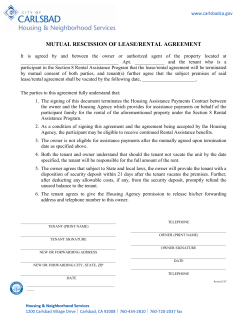
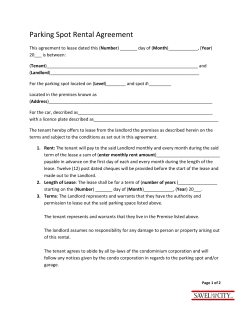
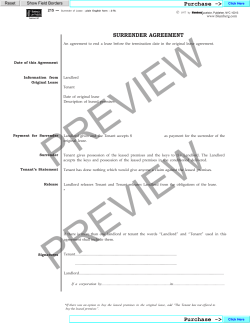
![Sample Letter: Improper Rule Change/Fee or Rent Increase [Date] [Landlord/Manager’s Name]](http://cdn1.abcdocz.com/store/data/000031198_2-6d3ce7b943ede5629a20f08c47060981-250x500.png)

